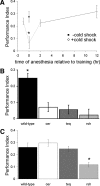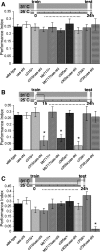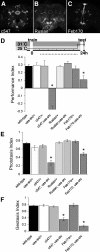Rapid consolidation to a radish and protein synthesis-dependent long-term memory after single-session appetitive olfactory conditioning in Drosophila
- PMID: 18354013
- PMCID: PMC2516741
- DOI: 10.1523/JNEUROSCI.5333-07.2008
Rapid consolidation to a radish and protein synthesis-dependent long-term memory after single-session appetitive olfactory conditioning in Drosophila
Abstract
In Drosophila, formation of aversive olfactory long-term memory (LTM) requires multiple training sessions pairing odor and electric shock punishment with rest intervals. In contrast, here we show that a single 2 min training session pairing odor with a more ethologically relevant sugar reinforcement forms long-term appetitive memory that lasts for days. Appetitive LTM has some mechanistic similarity to aversive LTM in that it can be disrupted by cycloheximide, the dCreb2-b transcriptional repressor, and the crammer and tequila LTM-specific mutations. However, appetitive LTM is completely disrupted by the radish mutation that apparently represents a distinct mechanistic phase of consolidated aversive memory. Furthermore, appetitive LTM requires activity in the dorsal paired medial neuron and mushroom body alpha'beta' neuron circuit during the first hour after training and mushroom body alphabeta neuron output during retrieval, suggesting that appetitive middle-term memory and LTM are mechanistically linked. Last, experiments feeding and/or starving flies after training reveals a critical motivational drive that enables appetitive LTM retrieval.
Figures







References
-
- Barco A, Alarcon JM, Kandel ER. Expression of constitutively active CREB protein facilitates the late phase of long-term potentiation by enhancing synaptic capture. Cell. 2002;108:689–703. - PubMed
-
- Barco A, Pittenger C, Kandel ER. CREB, memory enhancement and the treatment of memory disorders: promises, pitfalls and prospects. Expert Opin Ther Targets. 2003;7:101–114. - PubMed
-
- Carew TJ, Pinsker HM, Kandel ER. Long-term habituation of a defensive withdrawal reflex in Aplysia . Science. 1972;175:451–454. - PubMed
-
- Casadio A, Martin KC, Giustetto M, Zhu H, Chen M, Bartsch D, Bailey CH, Kandel ER. A transient, neuron-wide form of CREB-mediated long-term facilitation can be stabilized at specific synapses by local protein synthesis. Cell. 1999;99:221–237. - PubMed
Publication types
MeSH terms
Substances
Grants and funding
LinkOut - more resources
Full Text Sources
Medical
Molecular Biology Databases
